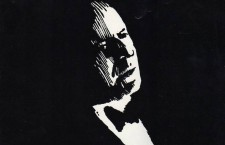Frank Sinatra’s first popular peak is found not at the table of some ring-a-ding casino lounge but inside a transistor radio, as the young crooner swept to girl-crazy acclaim in the late 1940s. Appearing on a variety of showcase programs, including the too-commercial Your Hit Parade (1943-44, and 1947-49) then his more personal Songs By Sinatra (1945-47) and finally here via On The Radio: The Lucky Strike ‘Lite-Up Time’ Shows 1949-1950, he sparked a frenzy of attention from bobby sox-clad junior misses — presupposing later sensations like Elvis Presley and the Beatles.
The schedule for the Lucky Strike cigarette-sponsored Lite-Up Time, typical of the era, was part of what turned into a devastatingly difficult routine for Frank Sinatra: This 15-minute program ran live Mondays through Fridays, and was done in and around a series of other concert and club performances — including a concurrent run at the legendary Copacabana, which featured singers as many as three times a night.
Too, he was warring with his producer at Columbia Records, Mitch Miller — the label had just begun to discover the financial windfalls of a quick-buck novelty song — as they worked on Sinatra’s initial long-player. Stupefying examples of the dreck foisted upon the singer during this period included the regrettable “One Finger Melody” and the unspeakable “Mama Will Bark,” thankfully nowhere to be found on this intriguing set of excerpts.
Instead, Sinatra is loose and emotionally available, usually appearing in front of an orchestra and chorus conducted by Jeff Alexander, who later wrote well-known film scores including The Tender Trap and Jailhouse Rock. Another standout within the largely anonymous backing group from On The Radio: The Lucky Strike ‘Lite-Up Time’ Shows 1949-1950, released by Acrobat on Oct. 21, 2008, is trumpeter Ziggy Elman. He takes a stirring turn on the rare “Every Time I Meet You” and then, doubling as conductor, on “I’ve Got a Crush On You,” both from 1949.
Fellow conductor Skitch Henderson and cornet player Bobby Hackett appeared on a number of Sinatra radio dates around this time — including this recording’s “Body and Soul,” from ’50. Frank’s warm duet with Dorothy Kirsten of “Some Enchanted Evening” is a standout, even if Sinatra can only confirm elsewhere that he always had a flair for corny in-concert banter. No matter. Fans will thrill to instructive early renditions of future Sinatra standards like “I Only Have Eyes For You” and “All of Me,” done in 1949. He’s working toward an utter command of the long notes (modeled after former trombone-playing boss Tommy Dorsey, with whom he recorded “Look What You’ve Done to My Heart,” among many others) that would define his singing style.
These Lite-Up Time shows, which conclude on April 1950, represent the very last examples of a sweeter, yet less nuanced sound by Frank Sinatra. He had a throat hemorrhage just a month later, famously opening his mouth to sing at the Copa and producing nothing but a raspy exhalation. Sinatra’s long recovery — both physically and as a hitmaker — led to deeper vocal shadings. He explored a new range that allowed him to bend notes to darker places, even while he worked on a more rhythmic delivery that accentuated the impact of a lyric.
It took some time, but Frank Sinatra eventually returned in the middle-1950s with a firmer grasp on where he wanted to go artistically, expanding on the small-scale triumphs found during these shows. The result was his brilliant and immortal Capitol sound.
- The Bright Spots in George Harrison’s Troubled ‘Dark Horse’ Era - December 29, 2024
- The Pink Floyd Deep Cut That Perfectly Encapsulates ‘The Wall’ - November 29, 2024
- Why Pink Floyd’s ‘The Endless River’ Provided a Perfect Ending - November 11, 2024



